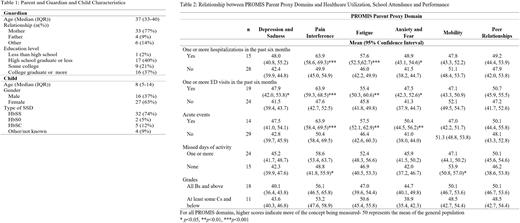Abstract
Background: Patient reported outcomes (PROs) can be critical in allowing the clinical team to understand patients' perspectives on their quality of life (QoL) and functioning. PROs can serve as a basis for fostering shared decision making and individualized care. Patients with sickle cell disease (SCD) often experience a high symptom burden and PROs can be an important tool for improving patients' health. In the case of pediatric patients, guardian proxy reports may give additional insight since children may be too young to complete assessments themselves. Additionally, guardian perceptions can influence healthcare-related decision making. Understanding the relationships between guardian-reported PROs with clinical outcomes, such as healthcare utilization, and functional impairment may provide a valuable tool for shaping clinical decisions. Here, we examine the relationships between the six domains of QoL using the parent proxy version of the Patient Reported Outcome Measurement System (PROMIS), healthcare utilization and functional limitations in children with SCD.
Methods: Pediatric patients and their guardians between the ages of 5 and 18 were approached while attending outpatient appointments at Children's Hospital of Richmond Comprehensive Sickle Cell Clinic. Children who were ill or in pain were excluded from enrollment during that visit. Consented guardians (n=43) completed a demographic questionnaire that included questions on recent healthcare utilization followed by the PROMIS Parent Proxy Pediatric Profile-25 with short forms assessing depression and sadness, pain interference, fatigue, anxiety and fear, mobility, and peer relations during the prior seven days. Outcome variables of interest included emergency department (ED) utilization and hospitalizations in the previous six months; acute SCD-related events in the prior year (acute chest syndrome, right upper quadrant syndrome, skeletal and joint issues, hand/foot issues, CNS involvement, acute anemia, sepsis, priapism), missed school days/planned activities due to SCD pain in the prior 30 days as well as academic performance. Counts and percentages were used to describe characteristics of children and guardians; t-tests were used to examine the relationship between domains of the PROMIS and outcome variables of interest. Specifically, we dichotomized all outcomes of interest, and then examined the means and 95% confidence intervals of the dichotomized groups for each of the PROMIS domains.
Results: Demographic characteristics of both guardians and children are described in Table 1. Thirty five percent of participants had a hospitalization and 44% had an ED visit in the previous six months, 33% had an acute SCD event in the prior year, 62% reported one or more missed days of school/activities and 38% reported grades lower than a B. Healthcare utilization (ED visit and hospitalization) and acute medical events were all significantly associated with higher levels of proxy-reported pain interference, fatigue, and anxiety/fear; ED visits was also associated with higher levels of proxy-reported depression and sadness (Table 2). Missed days of school were associated with greater proxy-reported pain interference and decreased mobility while none of the domains were associated with grades achieved.
Conclusions: Despite being administered during non-sick visits, multiple PROMIS Parent Proxy Pediatric Profile-25 domains that assessed QoL in the past seven days were associated with previous healthcare utilization in the past six months, acute medical events in the past year and missed school days in the past month. PROs can provide valuable information to clinicians, suggesting both the importance of addressing QoL outcomes for patients with recent healthcare events and the usefulness of guardian responses. The association of these PROs with clinical outcomes suggests that the PROMIS may be used prospectively to help identify and prevent further disease-related impairment and healthcare use.
Disclosures
No relevant conflicts of interest to declare.
Author notes
Asterisk with author names denotes non-ASH members.


This feature is available to Subscribers Only
Sign In or Create an Account Close Modal